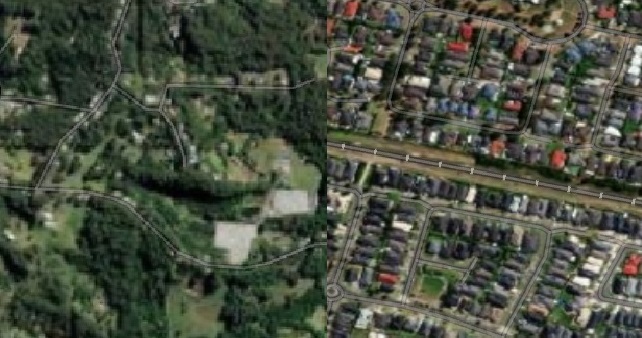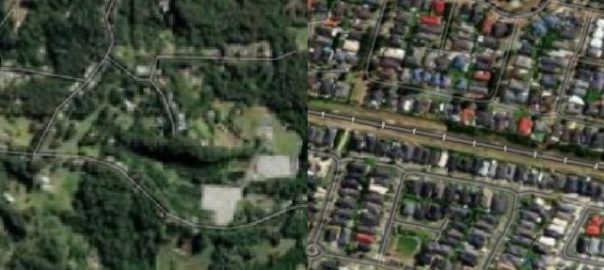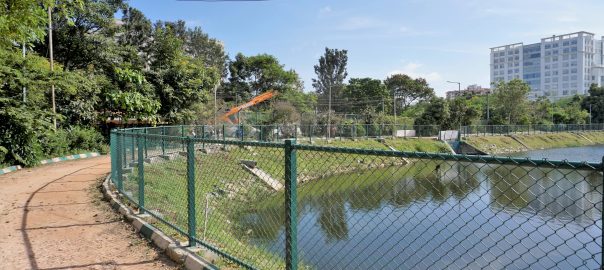Research on the association between neighborhood green and obesity is inconsistent. New indicators are needed to enable researchers to identify the optimal level of greenness that can help with this widespread public health challenge.
Obesity imposes a heavy burden on individuals and societies (Boutari and Mantzoros, 2022). Since obesity is difficult to cure and often coexists with other chronic conditions, public health efforts to prevent obesity are needed (McNally, 2024). However, a strategy focusing on individuals, simply telling people to eat less and exercise more, has not been successful (Blüher, 2019). It is important to consider the broader context in which people live their lives, as many people live in “obesogenic” environments, where it is difficult to engage in healthy behaviors.

Credit: Google (2024) Pakenham & Nambour
Greening neighborhoods could help to tackle obesogenic environments. Urban greenery (e.g., parks, gardens, street trees) has been shown to benefit human health through multiple pathways, such as providing an opportunity for physical activity and social interaction, lowering stress, reducing urban heat, and decreasing air pollution (Nieuwenhuijsen et al., 2017). Given that physically active lifestyles and lower levels of stress can minimize the risk of obesity (Cleven et al., 2020; Tomiyama, 2019), we can expect that urban greenery could protect against obesity. Increasing research has investigated whether living in greener neighborhoods is associated with a lower risk of obesity, but findings are inconclusive. While some literature reviews have reported higher levels of greenness to be associated with reduced risk of obesity in adults and in older adults (Liu et al., 2022; Yuan et al., 2021), there are also reviews showing mixed relationships between greenery and obesity measures (Chandrabose et al., 2019; Hadgraft et al., 2021).
A reason for the lack of consistent evidence linking urban greenery and obesity may lie in the way greenery is measured. Of the diverse methods to assess greenery, there are two common approaches. One focuses on parks or public green spaces, such as the number or size of parks within a certain area and proximity to the nearest park. These park-based metrics have been found mostly unrelated to obesity measures in previous reviews (Hadgraft et al., 2021; Luo et al., 2020). The other often-used measure of greenery is the level of greenness within a neighborhood, typically estimated using the Normalized Difference Vegetation Index (NDVI). This is a measure derived mostly from remote sensing satellite imagery, with higher values indicating denser vegetation (Martinez & Labib, 2023). Studies normally use mean or median NDVI of an area, but they have shown mixed findings in the association with obesity. For instance, higher levels of such NDVI measures were associated with reduced obesity risk in China (Huang et al., 2020) and the UK (Sarkar, 2017) but not in Australia (Daniel et al., 2019) or the US (Browning & Rigolon, 2018).
It is possible that these existing greenery measures do not capture aspects of greenery that are beneficial for reducing obesity. An Australian study showed that variability in NDVI (areas with high variability having distinct greenery, such as larger parks and a network of street trees along with non-green surfaces) was more strongly associated with risk of obesity, in comparison to mean levels of greenness (Pereira et al., 2013). The findings seem to suggest that a neighborhood dotted with dense greenery may be more beneficial to obesity prevention than an area covered evenly with sparse greenery. It can be thus argued that what might matter more is the availability of dense greenery, which is distinct from park-related measures or the average level of greenness across a neighborhood.
To clearly understand what aspects of neighborhood greenery can contribute to obesity prevention, we need to develop new measurement methods. We think that measures capturing the spatial distribution of greenery with different levels of greenness would be promising. Since public health data are often collected from a large sample recruited from diverse localities, new measures of greenery should be derived from readily available data (e.g., NDVI, Google Street views) rather than from bespoke measures applied to limited settings. New greenery measures may enable researchers to identify the optimal level of greenness that can support obesity prevention. Evidence from such research can help local governments to develop health-promoting greening strategies.
Takemi Sugiyama, Manoj Chandrabose, Nyssa Hadgraft, and Suzanne Mavoa
Melbourne
References
Blüher, M. (2019). Obesity: Global epidemiology and pathogenesis. Nature Reviews Endocrinology, 15(5), 288-298.
Boutari, C., & Mantzoros, C. S. (2022). A 2022 update on the epidemiology of obesity and a call to action: As its twin COVID-19 pandemic appears to be receding, the obesity and dysmetabolism pandemic continues to rage on. Metabolism, 133, 155217.
Browning, M. H., & Rigolon, A. (2018). Do income, race and ethnicity, and sprawl influence the greenspace-human health link in city-level analyses? Findings from 496 cities in the United States. International Journal of Environmental Research & Public Health, 15(7), 1541.
Cleven, L., Krell-Roesch, J., Nigg, C. R., & Woll, A. (2020). The association between physical activity with incident obesity, coronary heart disease, diabetes and hypertension in adults: a systematic review of longitudinal studies published after 2012. BMC Public Health, 20, 726.
Chandrabose, M., Rachele, J. N., Gunn, L., Kavanagh, A., Owen, N., Turrell, G., Giles-Corti, B., & Sugiyama, T. (2019). Built environment and cardio-metabolic health: systematic review and meta-analysis of longitudinal studies. Obesity Reviews, 20(1), 41-54.
Daniel, M., Carroll, S. J., Niyonsenga, T., Piggott, E. J., Taylor, A., & Coffee, N. T. (2019). Concurrent assessment of urban environment and cardiometabolic risk over 10 years in a middle-aged population-based cohort. Geographical Research, 57(1), 98-110.
Hadgraft, N., Chandrabose, M., Bok, B., Owen, N., Woodcock, I., Newton, P., Frantzeskaki, N., & Sugiyama, T. (2021). Low-carbon built environments and cardiometabolic health: A systematic review of Australian studies. Cities & Health, 6(2), 418-431.
Huang, W. Z., Yang, B. Y., Yu, H. Y., Bloom, M. S., Markevych, I., Heinrich, J., Knibbs, L. D., . . . Dong, G. H. (2020). Association between community greenness and obesity in urban-dwelling Chinese adults. Science of the Total Environment, 702, 135040.
Liu, X. X., Ma, X. L., Huang, W. Z., Luo, Y. N., He, C. J., Zhong, X. M., Dadvand, P., … Yang, B. Y. (2022). Green space and cardiovascular disease: A systematic review with meta-analysis. Environmental Pollution, 301, 118990.
Luo, Y. N., Huang, W. Z., Liu, X. X., Markevych, I., Bloom, M. S., Zhao, T. Y., Heinrich, J., Yang, B. Y., & Dong, G. H. (2020). Greenspace with overweight and obesity: A systematic review and meta-analysis of epidemiological studies up to 2020. Obesity Reviews, 21(11), e13078.
Martinez, A. d. l. I., & Labib, S. M. (2023). Demystifying normalized difference vegetation index (NDVI) for greenness exposure assessments and policy interventions in urban greening. Environmental Research, 220, 115155.
McNally, S. (2024). Preventing obesity is different from curing it—and even more urgent. BMJ, 384, q134.
Nieuwenhuijsen, M. J., Khreis, H., Triguero-Mas, M., Gascon, M., & Dadvand, P. (2017). Fifty shades of green: Pathway to healthy urban living. Epidemiology, 28(1), 63-71.
Pereira, G., Christian, H., Foster, S., Boruff, B. J., Bull, F., Knuiman, M., & Giles-Corti, B. (2013). The association between neighborhood greenness and weight status: An observational study in Perth Western Australia. Environmental Health, 12(1), 49.
Sarkar, C. (2017). Residential greenness and adiposity: Findings from the UK Biobank. Environment International, 106, 1-10.
Tomiyama, A. J. (2019). Stress and obesity. Annual Review of Psychology, 70, 703-718.
Yuan, Y., Huang, F., Lin, F., Zhu, P., & Zhu, P. (2021). Green space exposure on mortality and cardiovascular outcomes in older adults: A systematic review and meta-analysis of observational studies. Aging Clinical & Experimental Research, 33(7), 1783-1797.







Leave a Reply